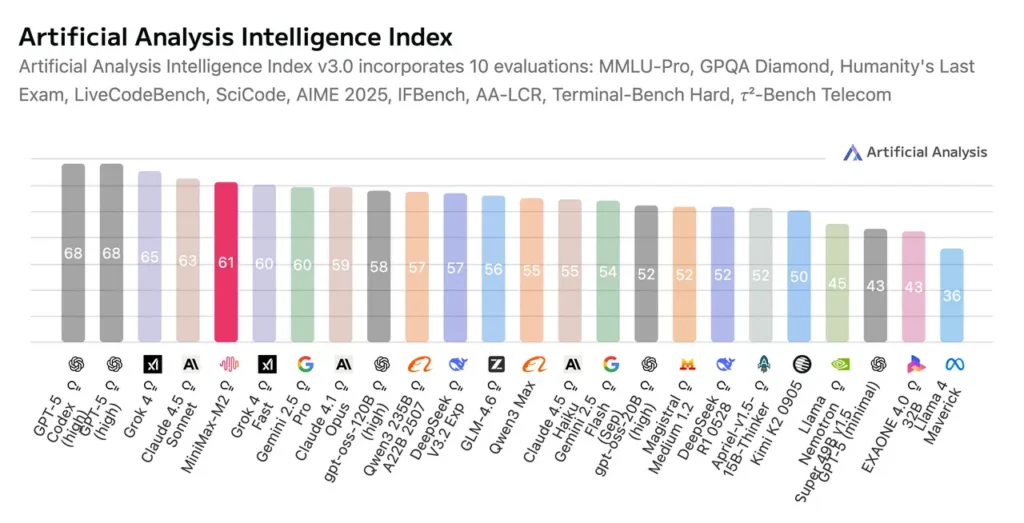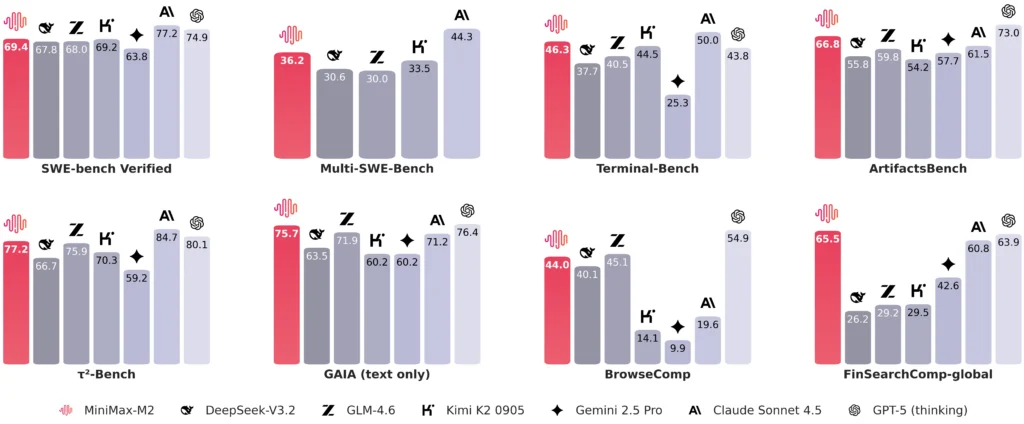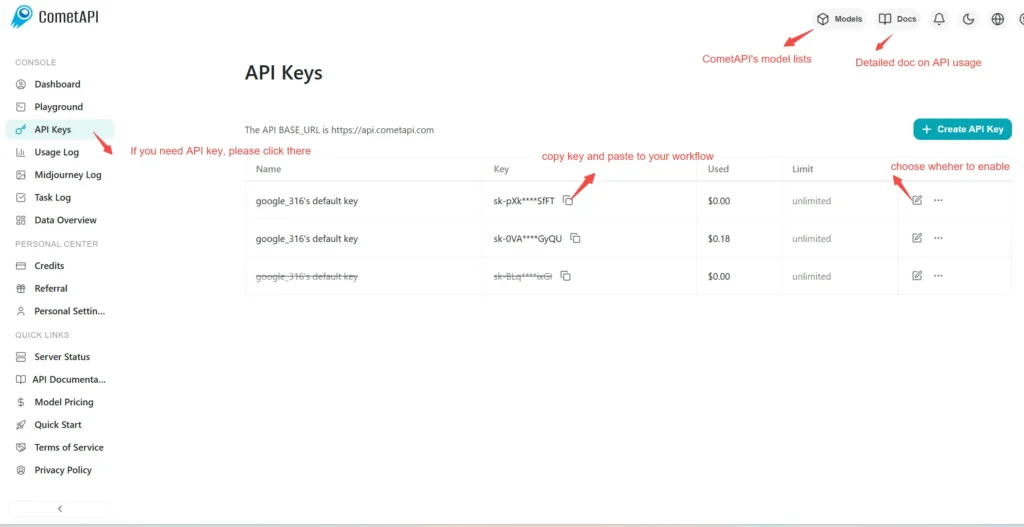MiniMax M2 ہے ایک اوپن سورس، ایجنٹ مقامی بڑے زبان کا ماڈل (LLM) MiniMax کے ذریعہ جاری کیا گیا ہے۔ اکتوبر 27، 2025. اس کے لیے واضح طور پر انجنیئر کیا گیا ہے۔ کوڈنگ اور ایجنٹ ورک فلو (ٹول کالنگ، ملٹی سٹیپ آٹومیشن)، ترجیح دینا کم وابستہ اور سرمایہ کاری مؤثر مضبوط استدلال اور آلے کے استعمال کی صلاحیتوں کی فراہمی کے دوران خدمت کرنا۔
کلیدی خصوصیات
جھلکیاں — کوڈنگ کی مہارت, ایجنٹ ورک فلو, کم ایکٹیو پیرامیٹر فوٹ پرنٹ, طویل سیاق و سباق کی حمایت, OpenAI- موافق API. MiniMax پوزیشنز Minimax M2 ایک تیز، تعیناتی کے لیے موزوں MoE ماڈل ملٹی سٹیپ ایجنٹس، کوڈ جنریشن اور مرمت، ٹرمینل/IDE ورک فلوز، اور ٹول کالنگ کے لیے بنایا گیا ہے۔
قابل ذکر گولیاں (فوری):
- فن تعمیر: ماہرین کا مرکب (MoE) ایک بہت بڑے پیرامیٹر کی تعداد کے ساتھ اور ایک چھوٹا چالو پیرامیٹر سیٹ فی فارورڈ پاس۔
- ایکٹیویشن فٹ پرنٹ: ~10 بلین فعال پیرامیٹرز (فی ٹوکن)
- کل پیرامیٹرز (رپورٹ کردہ): کے درمیان اطلاع دی ~200B - 230B ماخذ/میٹرک پر منحصر ہے (دیکھیں۔ تکنیکی تفصیلات).
- سیاق و سباق کی کھڑکی: انٹرپرائز پیمانے پر طویل سیاق و سباق؛ 204,800 ٹوکن زیادہ سے زیادہ سیاق و سباق
- بنیادی طریقہ کار: متن (ٹول کالنگ / فنکشن کالنگ سپورٹڈ)۔
- ایجنٹ مقامی: ملٹی سٹیپ ٹول کالنگ کے لیے ڈیزائن کیا گیا ہے (شیل، براؤزر، ازگر انٹرپریٹر، MCP ٹولز)۔
- کوڈنگ فوکس: ملٹی فائل ایڈیٹس، رن فکس لوپس اور CI/IDE ٹاسکس کے لیے بہتر بنایا گیا ہے۔
تکنیکی تفصیلات (فن تعمیر اور چشمی)
فن تعمیر - ماہرین کا مرکب (MoE): Minimax M2 API ایک MoE حکمت عملی استعمال کرتا ہے تاکہ ماڈل میں a ہو سکے۔ بہت بڑی کل پیرامیٹر کی گنتی جبکہ صرف ایک حصہ فی تخمینہ مرحلہ چالو کرنا۔ اس سے پیداوار بہتر ہوتی ہے۔ کمپیوٹنگ کی کارکردگی, تھرو پٹ، اور لاگت فی ٹوکن انٹرایکٹو ایجنٹ اور کوڈنگ لوپس کے لیے۔
درستگی اور کوانٹائزیشن - ماڈل فائلز اور پرووائیڈر سٹیکس کی فہرست FP32/BF16 اور FP8 فارمیٹس اور ایک سے زیادہ کوانٹائزڈ بلڈز (سیفٹینسرز، FP8/E4M3، وغیرہ)، مقامی تعیناتی اور کارکردگی کی تجارت کو فعال کرتے ہیں۔
سیاق و سباق اور I/O — تعینات فراہم کنندگان شائع کرتے ہیں۔ 204,800 ٹوکن سیاق و سباق کی حمایت اور بڑی زیادہ سے زیادہ آؤٹ پٹ ترتیبات۔ M2 ہے۔ صرف متن ابھی کے لیے (چین کی طرف سے بہت سے اوپن ویٹ ریلیز نے ٹیکسٹ/ایجنٹ کی صلاحیتوں پر زور دیا ہے جبکہ ملٹی موڈل دیگر ریلیز کا ڈومین بنی ہوئی ہے)۔
رن ٹائم سفارشات / خصوصی ہدایات - Minimax M2 API ایک استعمال کرتا ہے۔ "انٹرلیویڈ سوچ" آؤٹ پٹ فارمیٹ جو ماڈل کے اندرونی استدلال کو لپیٹتا ہے۔ <think>...</think> بلاکس MiniMax کی درخواست ہے کہ اس سوچ کے مواد کو برقرار رکھا جائے اور اسے تاریخی تناظر میں واپس منتقل کیا جائے تاکہ ملٹی ٹرن ایجنٹ ورک فلو کی کارکردگی کو محفوظ رکھا جا سکے۔
بینچ مارک کارکردگی
جامع ذہانت اور ایجنٹ بینچ مارکس - مصنوعی تجزیہ کی طرف سے آزاد بینچ مارکنگ کی اطلاع ہے کہ MiniMax-M2 نے اوپن ویٹ ماڈلز میں بہترین انٹیلی جنس انڈیکس حاصل کیا، اور کے درمیان درجہ بندی ٹاپ اوپن سورس ماڈلز جامع انٹیلی جنس میٹرکس پر، خاص طور پر آلے کا استعمال، ہدایات کی پیروی، اور ایجنٹ کے کام. مصنوعی تجزیہ ماڈل کو نمایاں کرتا ہے۔ کارکردگی (بہت کم فعال پیرامیٹرز) اس کی درجہ بندی کے کلیدی ڈرائیور کے طور پر۔

Minimax M2 شو کوڈنگ اور ایجنٹ سوٹ پر مضبوط نتائج (Terminal-Bench, SWE-Bench, BrowseComp, LiveCodeBench قسم کے کام)، جہاں اس کا فن تعمیر اور ایکٹیویشن بجٹ منصوبہ بندی → ایکٹ → تصدیق شدہ لوپس (تالیف/رن/ٹیسٹ سائیکل، ملٹی فائل ایڈیٹس، اور ٹول چینز) کے حق میں ہے۔

موازنہ: MiniMax M2 بمقابلہ دیگر عصری ماڈل
کھلے وزن والے ساتھیوں کے خلاف (DeepSeek، Qwen3، Kimi، وغیرہ) — Minimax M2 کے طور پر پیش کیا جاتا ہے۔ خاص طور پر موثر ایکٹیو پیرامیٹر بجٹ (≈10B) پر اسے مضبوط ذہانت فی ایکٹیو پیرامیٹر تناسب دیتا ہے۔ دوسرے کھلے ماڈلز میں زیادہ فعال پیرامیٹر کی گنتی ہو سکتی ہے لیکن ایک جیسے یا زیادہ کل پیرامیٹرز۔
کمرشل فرنٹیئر ماڈلز کے خلاف (اوپن اے آئی / اینتھروپک / گوگل / ایکس اے آئی) - رپورٹنگ مقامات M2 سب سے اوپر تجارتی ماڈل کے نیچے کچھ عمومی میٹرکس پر لیکن مسابقتی یا آگے؟ اس کے پرائس پوائنٹ کے لیے بہت سے ایجنٹ اور کوڈنگ بینچ مارکس پر۔
لاگت اور رفتار تجارت - اس کی فی ٹوکن قیمت اینتھروپک کلاڈ سونیٹ کا صرف 8% ہے اور اس کی رفتار تقریباً دوگنی ہے۔
حدود اور خطرات
حدود - فعلیت (زیادہ ٹوکن استعمال), صرف متن کا طریقہ, کام کی مخصوص کمزوریاں، اور معمول کے LLM خطرات (فریب، حد سے زیادہ اعتماد، ڈیٹاسیٹ تعصبات)۔ مصنوعی تجزیہ اور MiniMax دونوں اس بات کی نشاندہی کرتے ہیں کہ M2 کچھ بڑے جنرلسٹ ماڈلز کو کچھ کھلے کاموں پر کم کارکردگی کا مظاہرہ کر سکتا ہے یہاں تک کہ یہ ایجنٹی اور کوڈنگ ورک فلو پر سبقت لے جاتا ہے۔ کیونکہ یہ MoE پر مبنی ہے، تعیناتی کے تحفظات (ماہر روٹنگ، کوانٹائزیشن، اور انفرنس فریم ورک) معاملہ۔
آپریشنل انتباہات - Minimax M2 کی درمیانی سوچ فارمیٹ کو خصوصی برقرار رکھنے کی ضرورت ہے۔ <think>...</think> بہترین کارکردگی کے لیے تاریخ بھر میں ٹوکن؛ اس مواد کو ہٹانے سے ایجنٹ کا رویہ خراب ہو سکتا ہے۔ اس کے علاوہ، کیونکہ Minimax M2 لفظی ہے، فی کام لاگت دونوں کا ایک فنکشن ہے۔ فی ٹوکن قیمت اور کل ٹوکن بنائے گئے.
بنیادی استعمال کے معاملات
- ایجنٹ آرکیسٹریشن اور طویل ورک فلو - ملٹی سٹیپ ٹول چینز, براؤز کریں → بازیافت کریں → ایگزیکٹ سائیکل, غلطی کی بازیابی، اور ثبوت کا سراغ لگانا ایجنٹ چلتا ہے.
- ڈویلپر کی پیداوری اور کوڈنگ معاونین - compile-run-test loops, ملٹی فائل ایڈیٹس, ٹیسٹ کی توثیق شدہ مرمت، اور IDE انضمام (کلاڈ کوڈ، کرسر، کوڈیکس، گروک سی ایل آئی کی مثالیں موجود ہیں)۔
- ہائی تھرو پٹ ایجنٹ فلیٹ / پروڈکشن بوٹس — کہاں قیمت فی تخمینہ اور اتفاق معاملہ، M2 کا کم ایکٹیویٹڈ پیرامیٹر فوٹ پرنٹ بنیادی ڈھانچے کی لاگت کو کم کر سکتا ہے۔
کال کیسے کریں؟ Minimax M2 CometAPI سے API
minimax-m2 CometAPI میں API قیمتوں کا تعین، سرکاری قیمت میں 20% چھوٹ:
- ان پٹ ٹوکنز: $0.24 M ٹوکن
- آؤٹ پٹ ٹوکنز: $0.96/ M ٹوکن
مطلوبہ اقدامات
- داخل ہوجاو cometapi.com. اگر آپ ابھی تک ہمارے صارف نہیں ہیں، تو براہ کرم پہلے رجسٹر کریں۔
- سائن ان کریں CometAPI کنسول.
- انٹرفیس کی رسائی کی سند API کلید حاصل کریں۔ ذاتی مرکز میں API ٹوکن پر "ٹوکن شامل کریں" پر کلک کریں، ٹوکن کی حاصل کریں: sk-xxxxx اور جمع کرائیں۔

طریقہ استعمال کریں
- API کی درخواست بھیجنے کے لیے "minimax-m2" اینڈ پوائنٹ کو منتخب کریں اور درخواست کا باڈی سیٹ کریں۔ درخواست کا طریقہ اور درخواست کا باڈی ہماری ویب سائٹ API دستاویز سے حاصل کی گئی ہے۔ ہماری ویب سائٹ آپ کی سہولت کے لیے Apifox ٹیسٹ بھی فراہم کرتی ہے۔
- بدل دیں۔ آپ کے اکاؤنٹ سے اپنی اصل CometAPI کلید کے ساتھ۔
- مواد کے خانے میں اپنا سوال یا درخواست داخل کریں—یہ وہی ہے جس کا ماڈل جواب دے گا۔
- . تیار کردہ جواب حاصل کرنے کے لیے API جواب پر کارروائی کریں۔
CometAPI مکمل طور پر ہم آہنگ REST API فراہم کرتا ہے — بغیر کسی رکاوٹ کے منتقلی کے لیے۔ کی اہم تفصیلات API دستاویز:
- بنیادی URL: https://api.cometapi.com/v1/chat/completions
- ماڈل کے نام: "
minimax-m2" - توثیق:
Bearer YOUR_CometAPI_API_KEYہیڈر - مواد کی قسم:
application/json.
API انٹیگریشن اور مثالیں۔
ذیل میں ہے ازگر CometAPI کے API کے ذریعے GLM‑4.6 کو کیسے استعمال کرنا ہے اس کا ٹکڑا دکھا رہا ہے۔ بدل دیں۔ <API_KEY> اور <PROMPT> اس کے مطابق:
import requests
API_URL = "https://api.cometapi.com/v1/chat/completions"
headers = {
"Authorization": "Bearer <API_KEY>",
"Content-Type": "application/json"
}
payload = {
"model": "minimax-m2",
"messages": [
{"role": "system", "content": "You are a helpful assistant."},
{"role": "user", "content": "<PROMPT>"}
],
"max_tokens": 512,
"temperature": 0.7
}
response = requests.post(API_URL, json=payload, headers=headers)
print(response.json())
یہ بھی دیکھتے ہیں کلاڈ ہائیکو 4.5 API



